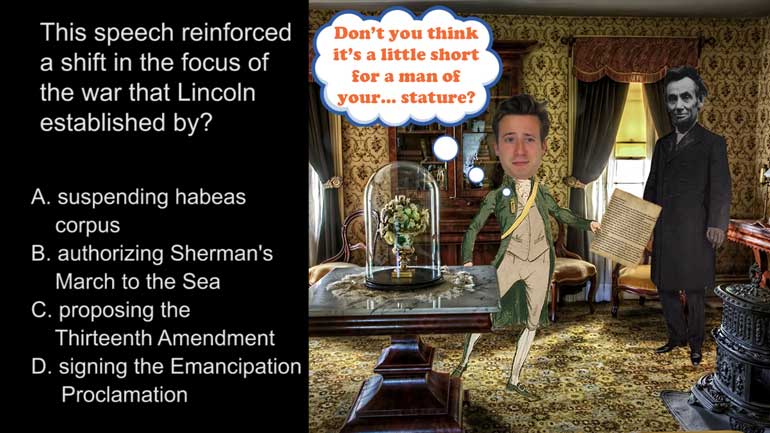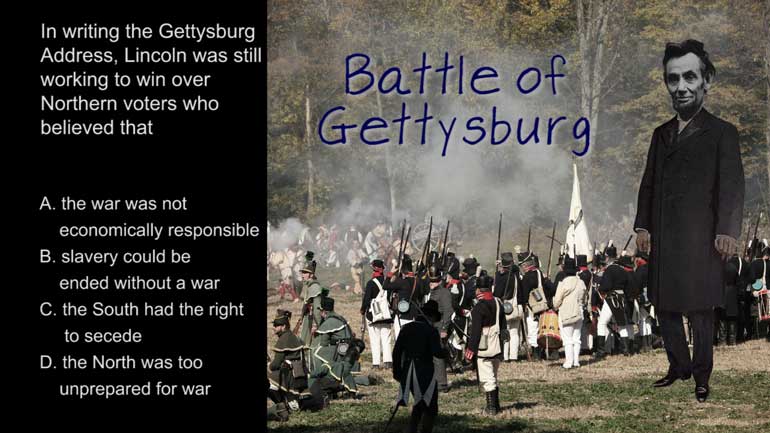ShmoopTube
Where Monty Python meets your 10th grade teacher.
Search Thousands of Shmoop Videos
AP U.S. History 2.2 Period 8: 1945–1980 196 Views
Share It!
Description:
AP U.S. History 2.2 Period 8: 1945–1980. The intent behind the Supreme Court's decision was primarily bolstered by what other developments in the 1940s, 50s, and 60s?
Transcript
- 00:00
[ musical flourish ]
- 00:03
And here's your Shmoop du jour, brought to you by judicial intent,
- 00:08
the Supreme Court's annual camping trip.
- 00:11
All right, check out this excerpt.
- 00:13
[ mumbles ]
Full Transcript
- 00:16
[ mumbling continues ] All right.
- 00:19
And the question:
- 00:20
The intent behind the Supreme Court's decision
- 00:23
was primarily bolstered
- 00:25
by what other developments in the 1940s, 50s, and 60s?
- 00:29
And here are your potential answers. [ mumbles ]
- 00:32
[ mumbling continues ] Hmm.
- 00:36
All right. Well, we know that Brown v. Board of Education
- 00:38
made the case against segregation in schools, but
- 00:42
what else could've been behind it?
- 00:43
Well, you know, other than it being the 100% right thing to do.
- 00:47
So let's see which answer makes those intentions clear.
- 00:50
Was the intent behind the Supreme Court's decision bolstered
- 00:53
by A - increased support for civil rights in the South?
- 00:58
Oh, man. Not in the least.
- 00:59
Not only did the South not support civil rights,
- 01:02
it actively worked against them.
- 01:03
George Wallace, the governor of Alabama,
- 01:06
gave a speech on his inauguration day that declared,
- 01:09
"segregation now, segregation tomorrow, segregation forever."
- 01:14
Tell us how you really feel, George.
- 01:15
Actually, don't bother.
- 01:17
Did the Supreme Court's decision emerge from
- 01:19
C - a more unified philosophical and tactical agenda
- 01:22
among civil rights activists?
- 01:24
Well, actually, faced with the aggressive bigotry by
- 01:27
people like Mr. Wallace here, civil rights activists
- 01:30
began to disagree over the best tactical
- 01:33
course to pursue in their fight to end discrimination.
- 01:36
C would have been great, but it wasn't in the cards.
- 01:39
Could the Supreme Court's judicial action have resulted from D -
- 01:42
economic gains made by African Americans?
- 01:44
Well, unfortunately, economic gains by African Americans
- 01:46
did little to end formal segregation,
- 01:48
since the racial and cultural prejudice against them
- 01:51
stretched back centuries.
- 01:53
Kind of hard to reason with hate and ignorance.
- 01:56
So it's not D, either.
- 01:57
Which means that the intent behind the Supreme Court's decision
- 02:00
was primarily bolstered by B -
- 02:03
executive and legislative measures
- 02:06
aimed at ending racial discrimination.
- 02:09
Civil rights activists weren't only fighting in the courts.
- 02:11
They also pressured the executive and legal branches
- 02:14
to take action against discrimination. And take action they did.
- 02:18
In 1948, President Truman issued Executive
- 02:20
Order 9981, abolishing racial discrimination in the military.
- 02:25
And in 1964, Congress passed the Civil Rights Act,
- 02:29
which prohibited discrimination based on race,
- 02:31
ended unequal voting registration practices,
- 02:34
and stopped segregation in schools and public workplaces.
- 02:38
So B is the correct answer. This triad of judicial decisions,
- 02:42
executive orders, and legislation
- 02:45
all aimed to end formal racial discrimination.
- 02:48
Well, maybe the best things really do come in threes.
- 02:52
[ thump ] [ yelp ]
Up Next
AP U.S. History Exam 2.45. The journey shown on the map was an example of...what?
Related Videos
AP U.S. History Exam 2.26. This speech reinforced a shift in the focus of the war that Lincoln established by...what?
What did the Spanish messengers bring with them to North America? Hint: you probably wouldn't be thrilled to get this for your next birthday.
AP U.S. History Diagnostic 24. How did the United States choose containment over the National Security Council Report in Latin America?
AP U.S. History Exam 2.25. In writing the Gettysburg Address, Lincoln was still working to win over Northern voters who believed that...what?




